Media façades, part 2
Media façade is an important high-tech component of the general urban landscape lighting topic. The following article continues description of some high profile media façade projects that was started in our February issue “Media façades, part1”.
Greetings from outer space: Urban Lighting
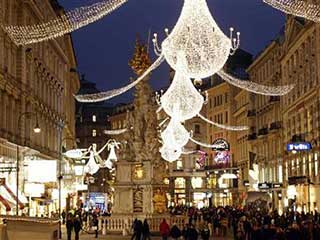
Austria, Vienna
Ball room lighting above shopping streets, light curtains on facades, chains of lights in parks and trees, skylines in Christmas glitter – every year cities and urban centers of all sizes turn into temporary light installations. However, looking at it from a distance, from outer space – it doesn’t need the holiday season. Our planet with its artificial lighting competes with stars millions of years old.
On 21 October 1879, Thomas Alva Edison would have been surprised when he had eventually succeeded in heating a charred cotton thread with electricity in a vacuum glass flask until it started to give light. Only three years later 400 Edison lamps lit up the first neighborhoods of New York City. Today the US alone spends more than two billion US dollars for lighting its public buildings. Twenty years ago the renowned Carnegie Institution had to shut down its observatory twenty miles off Los Angeles because the light above the nearby movie city not only grew faster than its population, but also outshone the distant stars.
Lighter, bigger, more colorful…
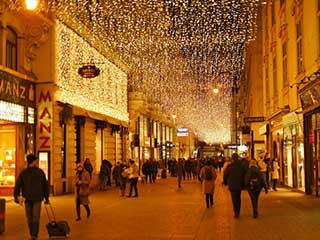
Austria, Vienna
There is no doubt that six billion people use a considerable amount of light. And those resources – like everywhere - are not distributed fairly and equally. Nor is there any doubt that our modern settlements are the way they are because of lighting in all imaginable forms – for functional purposes and design, always related to socio-cultural aspects.
Street lighting was one of the first accomplishments that not only provided comfort but also security and, obviously, status! Cities and neighborhoods that could afford it changed their gas lanterns for modern electricity earlier than others, and everything became possible – lighter, bigger, more colorful.
City lights
Nowadays street lighting and traffic control are essential parallel functions that keep the structures of urban settlements going. High tech controls traffic to avoid jams in its arteries, allowing not only mobility and movement, but also ensuring quality of life. More light - fewer accidents, more light less criminality – these are the basic equations used by city planners.
Light as a supporting element in urban planning started at least with the large world fairs of the 19th century, considered as experiments in modern lighting architecture. The Paris Eiffel Tower was a pioneer light house in 1889 and in the 1920’s illuminated facades became the fashion.
Ever since, architecture cannot do without lighting at night. Streets, squares, industrial plants, office buildings or satellite towns – light is used today because of its spatial qualities with equal regard to structure and orientation. Aesthetics combined with advanced (LCD) technology generate truly powerful landmarks, visible from afar and easily identifiable.
Light and shadow
As much light also causes much shadow this interaction must always be considered. Our language even has terms like activists and terrorists for people concerned with shielding from light. Under Germany’s Federal Law on Emissions, uncontrolled light has been defined as hazardous, like noise and fumes. It is not only a waste of energy, but, as critics claim, also disturbs the private sphere, it is a nuisance, distorts the landscape and damages the environment. Indeed, the latter is easy to prove – with 40 000 insects in Europe alone whose vision depends on darkness.
In the last few months, even the Municipality of New York City and the Audubon Society for Animal Protection ran a campaign by the name of “turn off the light”, trying to convince owners and renters of high rise buildings of more than forty stores to switch off the lights inside and outside after midnight to protect migrating birds. The Chrysler Building followed the call. But by the end of the birds’ migrating season at the latest, the lights will be on again, much to the joy of thousands of tourists, a nuisance to astronomers, for whom the sky is polluted on Earth...
Let’s continue looking at some other media façades
We would like to single out two successfully implemented projects among all other European projects: the first one – in Germany and another one – in Austria. Both of them were created by “Realities United”. This German studio specializes in the development of architectural design projects, which include dynamic informational representation in urban landscape. They believe that the architecture must be changeable and the buildings needn’t be static for a long term, but they have to change their appearance via the visual systems integrated. Their famous tools are media façades, such as BIX (Kunsthaus Graz) and SPOTS (Berlin, Potsdamer Platz), where the whole facade of a building transforms into a LED screen.
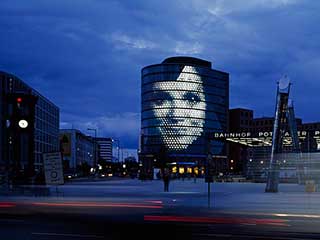
Sony Center’s media facade in Berlin
Famous square in Berlin, “Potsdamer Platz”, has undergone intensive aesthetic therapy; media-façade “Spots” was opened there. In the past, this used to be a place of the famous Berlin’s Wall. The area was destroyed almost completely during the Second World War. “Spots” is a matrix of 1 800 standard fluorescent lamps, installed in a glass facade. The matrix allows displaying visual imagery similar to LED screens.
 Media façade BIX Kunsthaus Graz
Media façade BIX Kunsthaus GrazMedia façade BIX is a famous interactive light-installation for Kunsthaus Graz, which is an international exhibition of modern art. BIX transforms the main eastern facade into the interactive membrane, emitting the information about the events passing inside for external audience. Beginning from its inauguration, BIX became an urban screen, which is used not for commercial purposes but for artistic imagery demonstration.
In architectural circles this vision seems disputable. Professionals admit that media façades hold promises for the future. Nevertheless, there are opinions discussed at the professional symposiums that media architecture and classical architectural canons are mutually contradictory. The thing is that the architectural community has to elaborate suitable combination of new technological possibilities and traditional architectural approach, which has been evolved for ages.
This is the heart of the problem
Usually, the architecture around us is static, and, to introduce changes, buildings must be reconstructed. Generations of architects and engineers dreamed about the buildings y structures, which were able to react and adapt itself rapidly to various requirements or circumstances changing their shape, space and functional configuration, lighting levels of the natural and artificial illumination, general ascetic appearance etc.
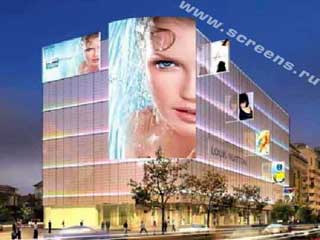 |
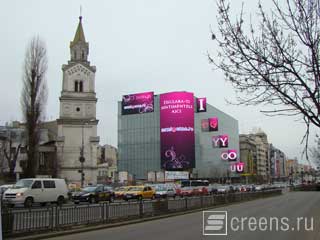 |
| Commercial center in Bucharest (project). Daktronics company. | LED screens project completed by Daktronics in the center of Bucharest |
Now a day when robot-architecture still remains far in future, the expected and important progress in the technology of digital visualization allows to project images on the building facade, thus transforming their appearance. Many architects are now calling this trend a “fourth dimension” and agree that it offers immense opportunities for creative work with urban landscapes.
 Media façade of Macau’s casino “Lisboa”
Media façade of Macau’s casino “Lisboa”As technology matures, the question about “where and how” to apply this technology to buildings remains open. Today, as soon as a facade transforms itself to a media façade, an architect loses control of it. The reason is money: it costs a lot to create a media façade and businessmen demand a return-on-investment, they need advertising and not abstract artistic images created by urban landscape specialists. As a result, commercial and creative aspects are at conflict and a building’s facade is in the middle of it.
Media façade projects have appeared in Moscow, the capital of Russia. We managed to take pictures of the media façade on the Hotel “Belgrade”. However, in this case, unfortunately, the brightness of the mounted LED-installation is hardly enough for nighttime viewing. It remains switched off in day time, as many similar projects around the world.
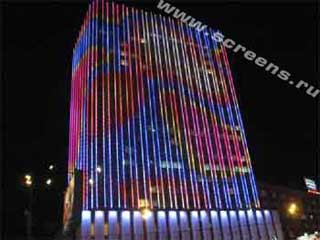 |
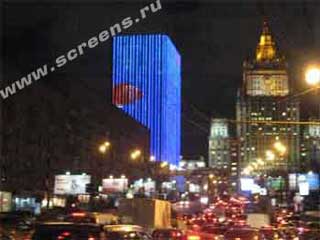 |
| Media façade of “Belgrade” hotel in Moscow | |
We are sure that engineers will come up with new solutions soon that would allow conquering not only the nighttime periods but day time as well. New projects appear around the globe literally every month. Our magazine certainly will return to this interesting topic in our future issues.





